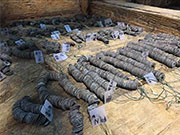

According to the Shanxi Institute of Archaeology, after two years of hard work, the excavation of the Zhou dynasty (1046 BC–256 BC) cemetery in Xiangfen County of north China's Shanxi province has yielded a rich discovery. A total of 1,283 tombs and three chariot pits have been uncovered. The site is a high-ranking noble cemetery of the Zhou Dynasty, which lasted for about 500 years. The discoveries are very meaningful to research on the Zhou Dynasty burial system.
A large number of bronze sacrificial items, instruments, chariots, harnesses, pottery, jade wares, gold vessels and other cultural relics have been unearthed, which reflect the burial rituals of that time.
From June 2014 to November 2015, archaeologists worked on this complex of tombs of the Zhou Dynasty in Xiangfen County. This cemetery covers an area of 240,000 square meters. Archaeologists pay close attention to the site because of frequent grave robberies.
In order to better protect the cultural relics, the Shanxi Institute of Archaeology and local cultural relics bureau conducted two excavations at the site from June 2014 to November 2015. So far, a total of 1,283 tombs and 3 chariot pits have been discovered, among which 12 tombs have already been excavated.
 |
Day|Week

 Spectacular aerial photos of the Three Gorges
Spectacular aerial photos of the Three Gorges New balls please! Polish sports stars strip off for risqué calendar
New balls please! Polish sports stars strip off for risqué calendar A glance at life of Ukrainian models working in Chongqing
A glance at life of Ukrainian models working in Chongqing Contestants of Mrs. Globe pose for photo in Shenzhen
Contestants of Mrs. Globe pose for photo in Shenzhen
 Bikini models attend hot pot banquet in Hefei
Bikini models attend hot pot banquet in Hefei 118-meter-high Never-used Building in NW. China Demolished
118-meter-high Never-used Building in NW. China Demolished J-10B fighters with homegrown engine in test flight
J-10B fighters with homegrown engine in test flight 10 tons of copper coins unearthed in 2,000 years old ancient tomb
10 tons of copper coins unearthed in 2,000 years old ancient tomb Beautiful graduate from police college becomes Internet hit
Beautiful graduate from police college becomes Internet hit Photos of U.S. Navy intruding in South China Sea released
Photos of U.S. Navy intruding in South China Sea released